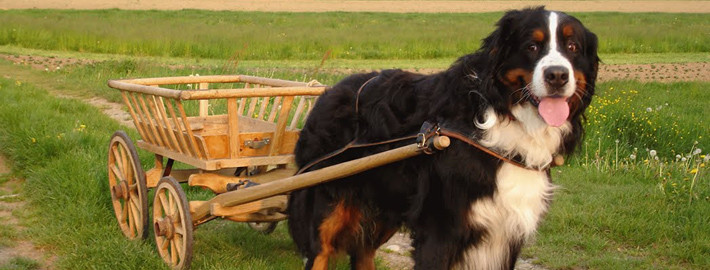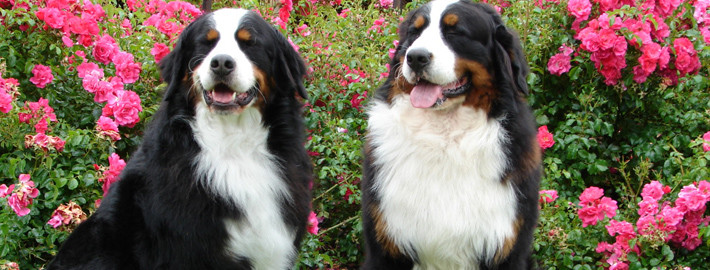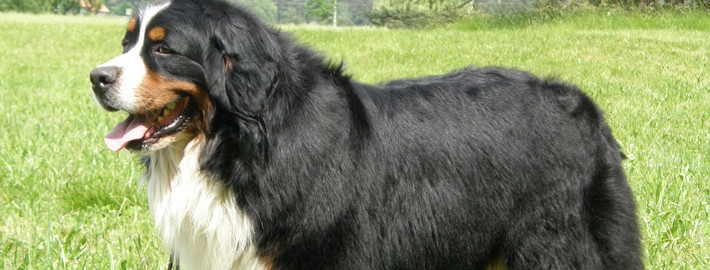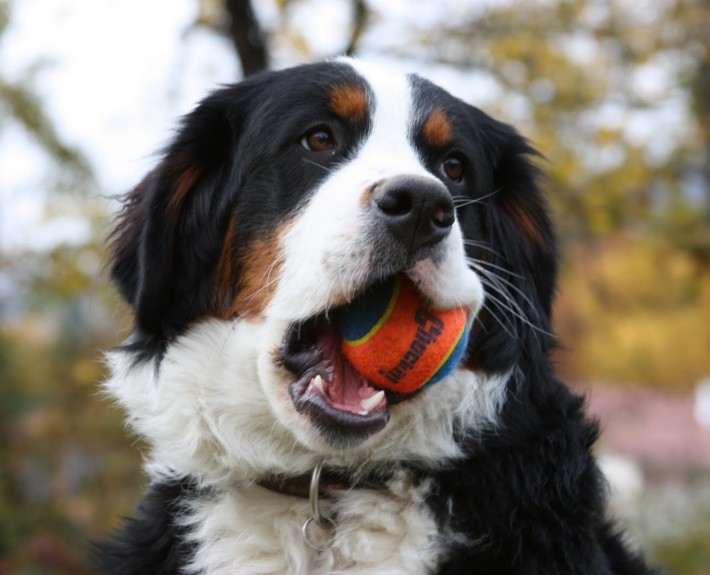What makes the Bernese Mountain Dog Unique?
The Bernese mountain dog is slightly longer than tall, though it appears square. It is a sturdy, large, hardy dog capable of both draft and droving work. This requires a combination of strength, speed and agility. Its natural working gait is a slow trot, but with good reach and drive. Its thick coat is moderately long, and slightly wavy or straight, providing insulation from the cold. Its expression is gentle, and its coloring is striking. The Bernese mountain dog is an easygoing, calm family companion (that is, after it leaves its adolescent stage). It is sensitive, loyal and extremely devoted. It is gentle with children and often reserved with strangers. It generally gets along well with other dogs and pets.
Breed Groups
Page Contents
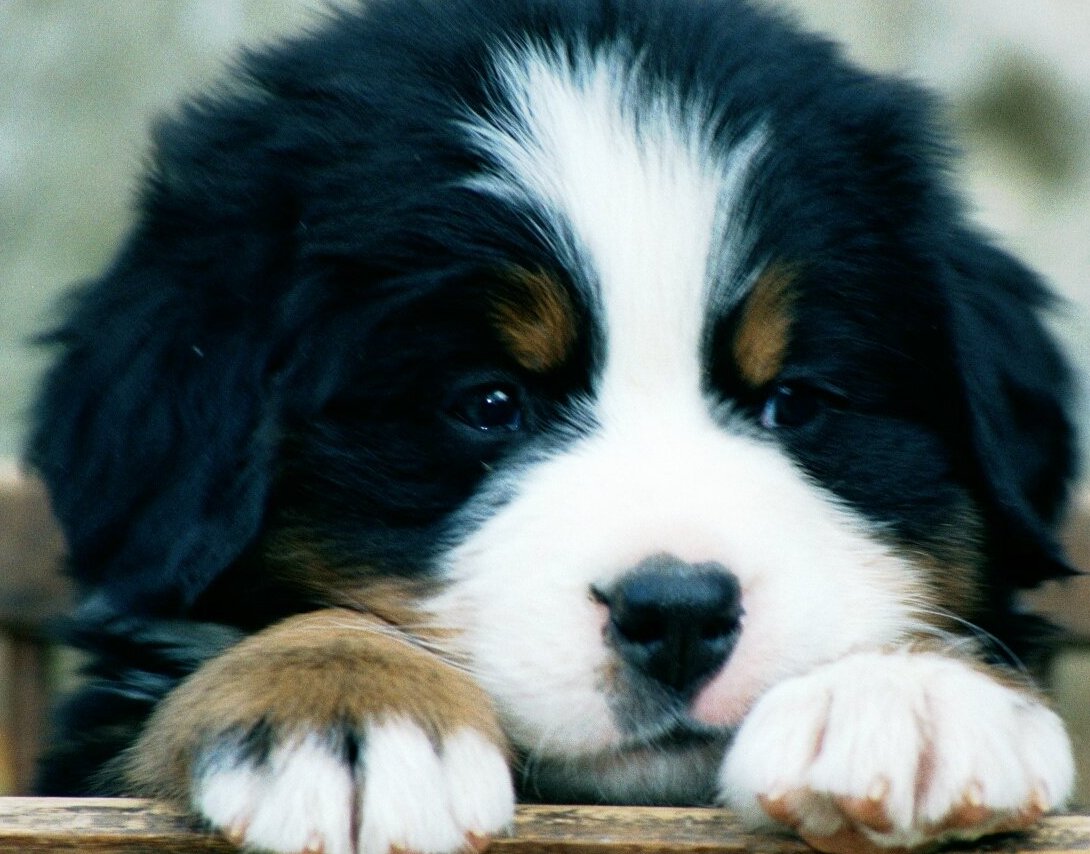
SnapShot
| Size: | Males – 64 to 70 cm (25 to 28 inches) Females – 58 to 66 cm (23 to 26 inches) |
| Weight: | Males – 39 to 50 kg (86 to 110.2 pounds) Females – 36 to 48 kg (79.4 to 105.8 pounds) |
| Origin: | Switzerland |
| Life Span: | 7 to 8 years |
| Colour: | Tricolor (black, rust, and white) |
| Litter Size: | 1 to 14 puppies, 8 is being common |
Is the Bernese Mountain Dog Right For You?
The Bernese Mountain Dog, like every dog, is descended from the wolf. Historically, in some locales at least, the breed was called a Dürrbachhund . the breed was used as an all purpose farm dog for guarding property and to drive dairy cattle long distances from the farm to the alpine pastures. The type was originally called the Dürrbächler, for a small town (Dürrbach) where the large dogs were especially frequent. The Bernese mountain dog is an easygoing, calm family companion (that is, after it leaves its adolescent stage). It is sensitive, loyal and extremely devoted. It is gentle with children and often reserved with strangers. It generally gets along well with other dogs and pets.
In 5 Words
- Loyal
- Faithful
- Intelligent
- Affectionate
- Loving
Characteristics
Learn About the Bernese Mountain Dog
Description
The Bernese Mountain Dog is a large, strong, sturdy, agile dog. The body is slightly longer than it is tall. The broad head is flat on the top with a moderate stop. The muzzle is strong and straight. The teeth meet in a scissors bite. The medium-sized, triangular ears are set high and rounded at the tip. The straight legs are strong. The bushy tail is carried low. Dewclaws are often removed. The feet are round with arched toes. The weather-resistant coat is moderately long, thick and slightly wavy or straight. The dog is tricolor with symmetrical markings of black, rust and white. The base of the dog is black. The dog has a white blaze on the chest, and white on the head, toes and tip of the tail. Rust is on the cheeks reaching to the corners of the mouth, over each eye, on each side of the chest, on all four legs and underneath the tail.
Short History of the Bernese Mountain Dog
The Bernese Mountain Dog, like every dog, is descended from the wolf. Historically, in some locales at least, the breed was called a Dürrbachhunde.
The breed was used as an all purpose farm dog for guarding property and to drive dairy cattle long distances from the farm to the alpine pastures. The type was originally called the Dürrbächler, for a small town (Dürrbach) where the large dogs were especially frequent. In the early 1900s, fanciers exhibited the few examples of the large dogs at shows in Berne, and in 1907 a few breeders from the Burgdorf region founded the first breed club, the “Schweizerische Dürrbach-Klub”, and wrote the first Standard which defined the dogs as a separate breed.
By 1910, there were already 107 registered members of the breed. There is a photo of a working Bernese Mountain Dog, dated 1905 at the Fumee Fall rest area in Quinnesec, MI.
Temperament
The temperament is self-confident, alert and good-natured, never sharp or shy. The Bernese Mountain Dog should stand steady, though may remain aloof to the attentions of strangers.
The Bernese Mountain Dog is a moderately active breed. He isn’t hyper, but because of his working background he does need some focused daily exercise for about 30 minutes. He also loves the outdoors, and makes an excellent hiking or camping companion.
Bernese Mountain Dogs also get along very well with most other animals, including other dogs and cats. As with any dog though it is important to make sure a puppy is well socialized and exposed to other pets in a positive environment.
Caring for Your Bernese Mountain Dog
General Health
The Swiss say: “Three years a young dog, three years a good dog, and three years an old dog…all else, a gift from God.” [Quoted from the BMDCSEW Puppy Buyer’s Guide.] Some of the health issues affecting this breed include hip and elbow dysplasia, cancer, bloat, sub-aortic stenosis, autoimmune diseases, thyroid disorders, eye diseases, and skin and coat problems.
If you are considering the adoption of a Bernese Mountain Dog puppy, or any breed, it is very important to be selective in choosing a responsible and reputable breeder. Ensure that the prospective puppy’s parents have all health clearances. This should include, among others, hip and elbow x-rays to exclude hip and elbow dysplasia and eyes should be checked to see that they are normal and PRA clear.
Grooming & Bathing
The Bernese calm temperament makes them a natural for pulling small carts or wagons, a task they originally performed in Switzerland. With proper training they enjoy giving children rides in a cart or participating in a parade. The Bernese Mountain Dog Club of America offers drafting trials open to all breeds; dogs can earn eight different titles — four as individual dogs (Novice Draft Dog, Advanced Novice Draft Dog, Draft Dog, and Master Draft Dog) and four brace titles, in which two dogs work one cart together. Regional Bernese clubs often offer carting workshops.
On July 1, 2010 the Bernese Mountain Dog became eligible to compete in AKC Herding Events. Herding instincts and trainability can be measured at noncompetitive herding tests. Berners exhibiting basic herding instincts can be trained to compete in herding trials.
Exercise & Training
Large active dogs such as these need regular exercise, which includes a long daily walk. It needs daily but moderate exercise, either a good hike or a walk on leash. It enjoys pulling. Although it can physically live outdoors in temperate to cold climates, it is so in tune with its human family that it cannot be relegated to life alone in the yard.
.

